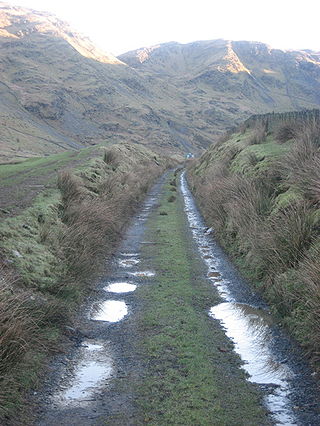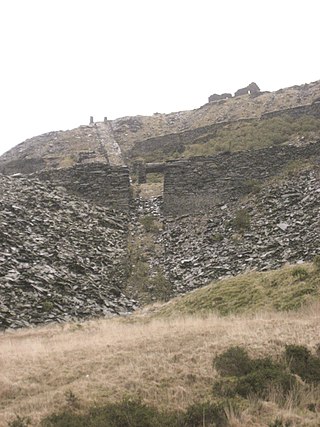
The Croesor Tramway was a Welsh, 2 ft narrow gauge railway line built to carry slate from the Croesor slate mines to Porthmadog. It was built in 1864 without an Act of Parliament and was operated using horse power.

Moelwyn Mawr is a mountain in Snowdonia, North Wales and forms part of the Moelwynion. Its summit overlooks the Vale of Ffestiniog and has views in all directions.

Tanygrisiau railway station is a passenger station on the narrow gauge Ffestiniog Railway The line was built in 1836 to carry dressed slate from Blaenau Ffestiniog to Porthmadog for export by sea but official passenger services began in 1865.

The Rhiwbach Tramway was a Welsh industrial, 1 ft 11+1⁄2 in narrow gauge railway connecting the remote slate quarries east of Blaenau Ffestiniog with the Ffestiniog Railway. It was in use by 1862, and remained so until progressively closed between 1956 and 1976. The route included three inclines, one of which became the last operational gravity incline in the North Wales slate industry. The tramway was worked by horses and gravity for much of its existence, but a diesel locomotive was used to haul wagons on the top section between 1953 and its closure in 1961.

Rhosydd quarry was a slate quarry in the Moelwyn mountains, northeast of Porthmadog in North Wales.

The Cwt y Bugail quarry is a former slate quarry located east of Blaenau Ffestiniog in Wales. It was first worked as a trial pit around 1840. Continuous production began in 1863 and continued until closure in 1961. The quarry was connected to the Ffestiniog Railway at Duffws Station via the Rhiwbach Tramway.

The Blaen y Cwm quarry was a slate quarry located east of Blaenau Ffestiniog in Wales. It was first worked in some time between 1813 and 1818 and sporadically after that until 1914. The quarry was connected to the Ffestiniog Railway at Duffws Station via the Rhiwbach Tramway.

Conglog quarry was a small enterprise situated to the north-west of Tanygrisiau, near Blaenau Ffestiniog in Wales. It was overshadowed by the much bigger Rhosydd quarry a little further to the west. It was active from 1854 to 1910, and was operated by an individual, two partnerships and four separate companies over this period.

Rhiwbach quarry was a slate quarry located to the east of Blaenau Ffestiniog in North Wales. The quarry was a remote site; it was nearly 4 miles (6.4 km) to north-east of Duffws, the Festiniog Railway's terminus in Blaenau Ffestiniog. It was the connected to the Ffestiniog Railway by the Rhiwbach Tramway. Commercial operation began around 1812, and it finally closed in 1952. It was the last Welsh slate quarry where workers lived in barracks on the site. 'Rhiwbach' is Welsh for 'Little Hill'.

Cwmorthin quarry was a slate quarry west of the village of Tanygrisiau, north Wales. Quarrying on the site started in 1810. In 1860 it was connected to the Ffestiniog Railway. In 1900 it was acquired by the nearby Oakeley quarry and the two were connected underground. In 1970 it closed along with Oakeley. There was small-scale working in the 1980s and 1990s, and the mine finally closed in 1997.

Votty & Bowydd quarry is a major slate quarry in the town of Blaenau Ffestiniog, North Wales. It was one of the major users of the Ffestiniog Railway. It opened in 1870 In the quarry's peak years around 1900, the quarry produced around 17,000 tons-per-annum of slate, employing 500 men. It continues to produce crushed slate on a limited scale under the ownership of the nearby Llechwedd quarry.

Graig Ddu quarry is a disused slate quarry near Blaenau Ffestiniog, in Gwynedd, North Wales. Although output was only about 3,000 tons a year, it reputedly has 36 saw tables and the same number of dressing machines on site. As with others in the area, the quarry suffered from a lack of water, resulting in the siting of the mill some distance away, at a lower level.

Nyth-y-Gigfran quarry was a slate quarry in the town of Blaenau Ffestiniog, North Wales. It was located about 300 feet (91 m) above the settlement of Glan y Pwll, south of what was to become Blaenau Ffestiniog. The quarry was sited on the steep cliffs that form the eastern edge of Allt-fawr and was entirely underground. The quarry opened around 1840 and became part of the Oakeley quarry in the 1880s; this in turn closed in 1969.

Moelwyn quarry is a defunct slate quarry located to the south of the village of Tanygrisiau, north Wales. Some initial prospecting was carried out in the 1820s and again in the 1840s, but it was 1860 before a company was formed, and chambers were excavated. The quarry was never a financial success, and operated sporadically until its demise in 1897. Despite the poor results, a spectacular series of seven inclines were constructed, to enable slates to reach the Ffestiniog Railway. The quarry was hampered by lack of a good water supply, and the mill was constructed between inclines 4 and 5, where water could be obtained from Llyn Stwlan. As in many quarries, barracks were provided, but these were occupied by whole families, living on the mountain, rather than used as lodgings for the quarrymen during the working week. Even in its remote location, there was still a concern for education, with basic literacy classes being run in the 1860s.
The Cwmorthin Tramway was a 1 ft 11+1⁄2 in industrial tramway in North Wales, which connected the Ffestiniog Railway to the Cwmorthin Quarry and later the Conglog Slate Quarry. It was built in the 1840s or 1850s, rising through two inclined planes to reach the main Cwmorthin Quarry mill and its internal incline which rose from floor 1 to floor 8. In 1874, it was extended, rising up through a third incline to the Cwmorthin Lake level and continuing along the valley floor to reach the Conglog Quarry. The tracks to Conglog were abandoned in the 1920s and the rest of the tramway ceased to be used from the onset of the Second World War.

Parc Quarry was a compact underground slate quarry in the Croesor Valley, Gwynedd, North Wales. It was connected to the Croesor Tramway, which ran through the valley. The quarry concentrated on producing specialist slate products, rather than roofing slates, and was managed for much of the time by the innovator Moses Kellow. It operated for about 50 years, from 1870 to 1920.

Fron-Boeth and Pant Mawr quarries were two closely related and interconnected quarries on the western slopes of Moelwyn Mawr in Gwynedd, North Wales. Pant Mawr operated from around 1850 to 1879, and was partly re-opened in 1886 when it was amalgamated with Fron-Boeth. Both quarries closed during the First World War. Finished product was transported to the slate quays of Porthmadog by the Croesor Tramway.

The Penmachno quarry was a slate quarry near Cwm Penmachno, Conwy, North Wales. It was directly below the Rhiwbach Quarry. It was worked between 1818 and 1962.

Bwlch y Slaters quarry is a slate quarry near Blaenau Ffestiniog, in Gwynedd, North Wales.





















